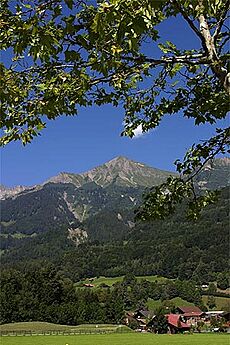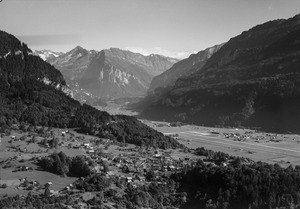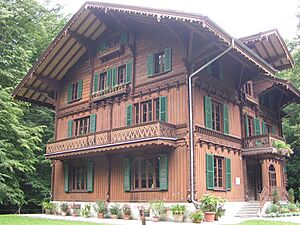Brienzwiler facts for kids
Quick facts for kids
Brienzwiler
|
||
|---|---|---|

Bernese farmhouse at the Ballenberg Open Air Museum near Brienzwiler village
|
||
|
||
| Country | Switzerland | |
| Canton | Bern | |
| District | Interlaken-Oberhasli | |
| Area | ||
| • Total | 17.64 km2 (6.81 sq mi) | |
| Elevation | 680 m (2,230 ft) | |
| Population
(Dec 2020 )
|
||
| • Total | 481 | |
| • Density | 27.27/km2 (70.62/sq mi) | |
| Postal code |
3856
|
|
| Surrounded by | Brienz, Grindelwald, Hofstetten bei Brienz, Lungern (OW), Meiringen | |
Brienzwiler is a small town, also called a municipality, in Switzerland. It is located in the Interlaken-Oberhasli area within the canton of Bern. Besides the main village of Brienzwiler, the town also includes a smaller settlement called Balmhof.
Contents
History of Brienzwiler
Brienzwiler was first mentioned in old writings in the year 1347. Back then, it was known as Wiler am Brünig.
Long ago, during the Middle Ages, Brienzwiler was owned by a group of knights called the Rudenz family. These knights served powerful lords from Ringgenberg. The Rudenz family kept the village until 1361. Then, they sold it to a person from Bern. Over the next years, the village changed owners many times. It was also divided into smaller parts. Finally, in 1522, the city of Bern bought the entire village.
When Bern changed its official religion to Protestantism in 1528, they took over lands from the nearby Interlaken Monastery. Some of this land was close to Brienzwiler. Bern then made Brienzwiler part of a new area called the bailiwick of Interlaken. A bailiwick was like a district managed by a local official.
Brienzwiler is part of the larger church area of Brienz. However, since the early 1900s, Brienzwiler has had its own smaller church and cemetery.
In the past, people in Brienzwiler mostly earned money from farming in the Aare river valley. They also practiced seasonal alpine herding. This means they moved their animals to high mountain pastures in summer. Travelers using the Brünig Pass also brought some money to the village.
In the 1800s, a small tourism industry started in Brienzwiler. In 1888, a train station opened on the Brünig railway line. This made it easier for more tourists to visit. Today, the local economy relies on wood carving, government jobs, hotels, and tourism. The famous Ballenberg Open Air Museum is also a big part of the local economy.
Geography and Landscape
Brienzwiler covers an area of about 17.6 square kilometers (6.8 square miles). A good portion of this land, about 30.8%, is used for farming. Forests cover another 33.5% of the area.
About 2.9% of the land has buildings or roads. A small part, 0.8%, is rivers or lakes. The remaining 31.8% is land that cannot be used for farming or building. This includes rocky areas or places with little plant life.
Brienzwiler is located on both sides of the Aare River. North of the Aare, you'll find the villages of Brienzwiler and Balmhof. There are also smaller settlements like Wiler-Vorsass and Ramseren. The peak of the Wilerhorn, which is about 2,005 meters (6,578 feet) high, is also in this area. South of the Aare, there is a separate piece of land called Alp Oltscheren. This is an exclave, meaning it's a part of Brienzwiler that is not connected to the main area.
At the end of 2009, the old district of Interlaken was closed. On January 1, 2010, Brienzwiler became part of the new Interlaken-Oberhasli district.
Coat of Arms
The blazon of Brienzwiler's municipal coat of arms shows a red tower with battlements on a silver band, all on a blue background.
People of Brienzwiler (Demographics)
As of 2010, Brienzwiler had a population of 511 people. About 7.8% of these people were foreign nationals. Over the past 10 years (2000-2010), the population has decreased slightly.
Most people in Brienzwiler speak German as their first language. In 2000, about 93.6% of the population spoke German. Albanian was the second most common language, spoken by 4.0% of people. A small number of people also spoke English, French, or Italian.
In 2008, the population was almost evenly split between men and women. About 49.7% were male and 50.3% were female. Most residents were Swiss citizens.
In 2010, children and teenagers (ages 0–19) made up about 20.9% of the population. Adults (ages 20–64) made up 60.3%, and seniors (over 64 years old) made up 18.8%.
The population of Brienzwiler has changed over time. For example, in 1880, there were 760 people. By 2000, the population was 580.
Important Heritage Sites
The Swiss Open Air Museum, Ballenberg (also known as Schweizerisches Freilichtmuseum Ballenberg), is a very important place. It is shared with the nearby town of Hofstetten. This museum is listed as a Swiss heritage site of national significance. This means it's a very important cultural place for the whole country. The entire village of Brienzwiler is also part of the Inventory of Swiss Heritage Sites.
Economy and Jobs
In 2011, the unemployment rate in Brienzwiler was low, at 1.28%. This means very few people were looking for jobs but couldn't find one.
In 2008, 97 people worked in Brienzwiler.
- About 18 people worked in the primary sector. This includes jobs like farming and forestry.
- About 22 people worked in the secondary sector. This includes jobs in manufacturing and construction.
- About 57 people worked in the tertiary sector. This includes jobs in services, like hotels, restaurants, sales, and healthcare.
Many people who live in Brienzwiler travel to other towns for work. In 2000, 181 people left Brienzwiler for work, while only 58 people came into Brienzwiler to work. Most people used a private car to get to work, while some used public transportation.
Religion in Brienzwiler
Based on information from 2000, most people in Brienzwiler belong to the Swiss Reformed Church. About 76.2% of the population were members of this church. About 7.1% were Roman Catholic. There were also people who belonged to other Christian churches or were Islamic. A small number of people did not belong to any church.
Education
In Brienzwiler, about 39.7% of the population has completed upper secondary education. This is like finishing high school. About 6.9% have gone on to higher education, such as university or a specialized college (a Fachhochschule).
In the 2010-2011 school year, no students were attending school directly in Brienzwiler. However, 69 students from Brienzwiler went to schools in other towns.
Transport
Brienzwiler has a train station called Brienzwiler railway station. It is on the Brünig railway line. A train called Regio stops here every hour. It travels between Interlaken and Meiringen. The station is about 1.5 kilometers (0.9 miles) southwest of the main village.
The village of Brienzwiler also has a post bus service. Buses run twice an hour from Brienz.
Images for kids
See also
 In Spanish: Brienzwiler para niños
In Spanish: Brienzwiler para niños










